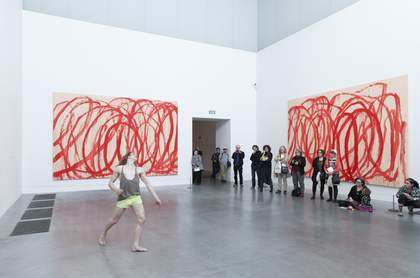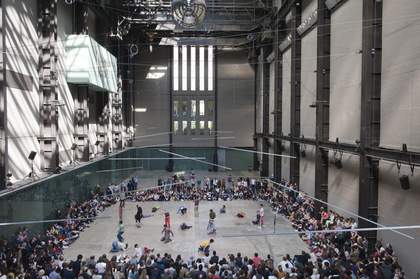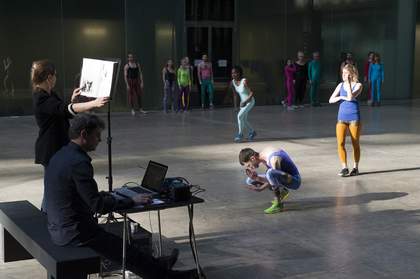Spanning the glass panes of the building’s façade, the expansive proposition ‘If Tate Modern was Musée de la danse?’ slowly impressed itself on me as I approached the museum from the Millennium Bridge on day one of its 48-hour ‘occupation’ by another institution: the Rennes-based but itinerant Musée de la danse. The tentative way in which the question was phrased made it less of a rebranding exercise, perhaps, yet it gave a measure of the project’s scale and ambitions. Above all, it seemed to invite an imaginative leap.
In his 2009 Manifesto for a Dancing Museum – penned the year he became director of the Centre chorégraphique national de Rennes, promptly renamed Musée de la danse – dancer and choreographer Boris Charmatz described what he and his collaborators envisioned as ‘a viral museum which can be grafted on to other places’. Judging by the public’s response to the temporary takeover, both in situ and on social media, Tate Modern-turned-Musée de la danse really did go viral. As one commentator aptly put it in a Facebook post: ‘Everyone’s gone nuts for it.’ But was the relationship between the host institution and the joyously invasive, parasitical species that is Musée de la danse one of symbiosis?
This was hardly the first time Charmatz’s Dancing Museum had strutted its stuff in a gallery setting; neither was contemporary dance staged amid Tate Modern’s collections unprecedented. Leaving aside the performances that took place in the dedicated space of the Tanks, members of Trisha Brown’s dance company had re-created her Early Works from the 1970 s in the Turbine Hall and galleries as part of Dance Umbrella 2010. Parts of the Musée de la danse in its Tate Modern incarnation had already featured in the 2011 Performa biennial, and the Museum of Modern Art in New York staged three pieces choreographed by Charmatz over three consecutive weekends in October/ November 2013.

François Chaignaud as part of 20 Dancers for the XX century by Boris Charmatz
Photo: Joe Humphrys © Tate Photography
2015
But the Tate Modern/Musée de la danse was an altogether more radical idea. What made it so was not only the sheer scale of the enterprise with its core 90-odd participants, most of them dancers, and its varied formats calling for different degrees of audience participation, but also the ability to enjoy what the Dancing Museum has to offer free of charge, opening it up to a global audience through live streaming.
Of the three discrete strands that made up this hybrid museum body, expo zéro and its coterie of artists, curators, choreographers and thinkers moving freely across four empty gallery spaces in ever-shifting configurations was the one I spent least time with on this occasion, though I remember falling under its discursive spell elsewhere. The constant stream of visitors did not allow for any kind of intimate or meaningful exchange, and I came away from this ‘laboratory of ideas’ with no real insights into what a museum of dance might be.

Ko Murobushi as part of 20 Dancers for the XX century by Boris Charmatz
Photo: Joe Humphrys © Tate Photography
2015
Far more instructive and thought provoking in this respect was 20 Dancers for the XX Century, which took over the collection galleries and landing areas on all three levels, barring the (paying) temporary exhibition spaces. These were off-bounds in a tacit acknowledgment of the disruptive character of the Dancing Museum. Indeed, anyone who visited Tate Modern that weekend hoping to commune with the objects on display would have faced an impossible task. But part of the pleasure that drifting across this section of the museum afforded lay precisely in the occasional moments of symbiosis between the dancing bodies and the surrounding artworks. Feminist artist Sanja Ivekovic’s performance pieces unfolding in front of Andy Warhol’s 1962 Marilyn Monroe diptych or Butoh-founder Tatsumi Hijikata’s dances in the Arte Povera and Anti-Form room were both perfectly matched to their setting.

Boris Charmatz Levée des conflits
Photo: Brotherton Lock ©Tate Photography, 2015
What the dancers unleashed on Tate by Charmatz set out to activate was not so much the space and the objects held therein as the museum-goers themselves. ‘Dancing is for everybody,’ Charmatz repeatedly assured the crowd gathered inside the Turbine Hall, transformed into a dance floor with little more than a giant glitter ball and a DJ station tucked away beneath the bridge for the Adrénaline sessions. Led by Charmatz, who directed the well-attended public warm-ups at the start of each day, a team of dancers clad in fluorescent pink and yellow T-shirts took people of all ages and abilities through complex sequences of movements in the visitor version of the Levée des conflits – one of four pieces spanning the choreographer’s career performed amid the audience on the east side of the Turbine Hall.

Boris Charmatz, Roman Photo
Photo: Brotherton Lock © Tate Photography 2015
Was the Musée de la danse merely a playful interlude, or a dress rehearsal for Tate to come as the completion of its expansion and the reopening of the Tanks draw near? The museum of the future as embodied in Charmatz’s ephemeral proposal for Tate Modern would let itself be colonised by other art forms; it would sometimes do away with objects altogether; it would seek to involve the visitors, turning them from passive spectators into active participants; it would aspire to be more like an open-ended repertoire than a fixed archive; it would appeal to all the senses, not just vision.
